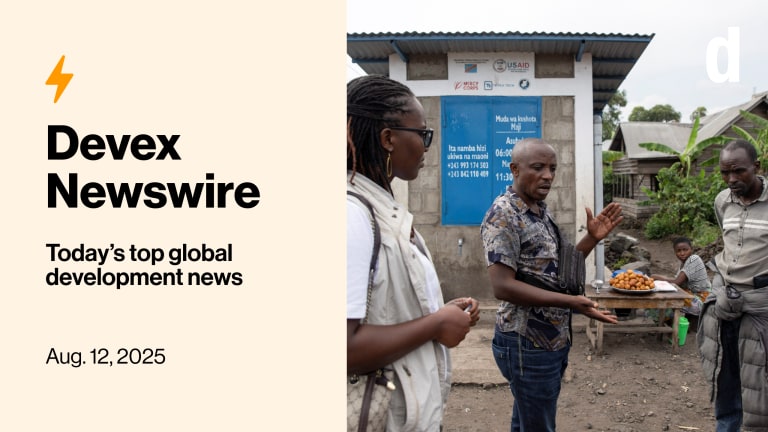USAID Forward: Where the local funding is going
In this exclusive data analysis, Devex finds that USAID local funding for host governments dwarfs funding for nonprofits — provided AfPak is kept in the equation. Strikingly, we also found that affiliates of international NGOs and networks rank among the agency’s largest local nongovernmental partners.
While hardly the only major donor to steadily move funding to the local level in recent years, few donors have been as ambitious in going local as the U.S. Agency for International Development. Back in 2010, USAID Administrator Rajiv Shah set the target of funneling 30 percent of USAID’s funding to local organizations by fiscal 2015 — a key pillar of his sweeping reform agenda called USAID Forward. Four years on, USAID’s latest data set on USAID Forward — released in April — reveals that the agency is now more than halfway toward its 30 percent local funding target. According to the agency’s data set, which only tracks direct awardees, 17.9 percent of the agency’s funding was channeled to local organizations in fiscal 2013 — up from 14.3 percent in fiscal 2012 and 9.7 percent in fiscal 2010. Devex dug deeper into the data to analyze key trends in USAID’s local funding across its global portfolio. Here are our three conclusions. Some USAID missions are much further along on localization, in part due to US foreign policy considerations From the early days of USAID Forward, agency officials have emphasized that USAID’s goal of channeling 30 percent of its funding locally is a global aggregate target — one that’s designed to provide its missions with enough flexibility to respond to individual country context while also holding the agency accountable for its commitment to go local. USAID doesn’t anticipate that each of its missions around the world will channel 30 percent of their funding to local organizations by 2015. In fact, in countries with weaker government institutions and less robust civil society, the agency may not even come close. Our data analysis reveals that some USAID missions are indeed much further along on localization than others. In fiscal 2013, 12 of 76 missions already exceeded the fiscal 2015 agencywide localization target of 30 percent — with Paraguay (82.2 percent), Egypt (65.5 percent) and the Dominican Republic (62.4 percent) at the top of the leaderboard. Fifty-three missions, on the other hand, were below the fiscal 2013 agencywide localization share of 17.9 percent. USAID missions in Mongolia, South Sudan and Sudan recorded a zero percent localization share. U.S. foreign policy considerations seem to be as much of a driver of where USAID goes local the furthest — if not more — as host country readiness. Afghanistan and Pakistan — two USAID programs of strategic importance to the United States that have been tainted by a steady stream of corruption allegations — both exceeded the agencywide local spending target of 30 percent in fiscal 2013. If Afghanistan and Pakistan are counted as a single region, their localization share would top 36 percent — more than double any other region in USAID’s portfolio. In 2012, USAID had cited U.S. foreign policy objectives in waiving its requirement for a public financial management risk assessment of the Afghan government — the single-largest recipient of USAID local funding. Notably, South Africa — the largest recipient of U.S. HIV and AIDS assistance over the past decade — far exceeded the 30 percent agencywide target, which is likely explained less by U.S. foreign policy considerations than by Washington and Pretoria’s joint commitment to gradually transition PEPFAR programming to more sustainable, local ownership. One of a handful of missions that have set their own localization targets, USAID South Africa claims that it is on track to channel 65 percent of its funding locally by fiscal 2015. As of fiscal 2013, the mission had obligated 58.5 percent of its funding to local organizations, up from 47.8 percent the year before. USAID local funding for host governments dwarf funding for local nonprofits — but only if AfPak is included As U.S. aid veterans will recall, through the 1980s, USAID channeled a large portion of its funding through host governments — that was until the agency was badly burned by a flurry of investigations over the misuse of U.S. aid dollars on Capitol Hill. Keenly aware that lawmakers remain suspicious of direct U.S. assistance to host governments, USAID officials have touted USAID Forward’s commitment to engage with a broad swath of local partners, including nonprofit organizations, for-profit entities and educational institutions. Contrary to what might be expected, however, our data analysis reveals that the bulk of USAID funding for local organizations (55 percent) was obligated to host governments in fiscal 2013 — up from 49 percent in fiscal 2012. Meanwhile, nonprofits were obligated 31 percent of USAID’s local funding in fiscal 2013, while for-profits and educational institutions were obligated 12 percent and 2 percent, respectively. At the same time, we found that USAID funding for host governments is concentrated in a select number of missions. In fiscal 2013, only 14 of 74 missions obligated most of their local funding for host governments, while 48 missions obligated most of their local funding for nonprofits. In fact, when Afghanistan and Pakistan — whose governments received direct aid from Washington even prior to USAID Forward — are removed from the picture, then nonprofits actually garnered the majority (53 percent) of USAID funding for local organizations in fiscal 2013. Initially, USAID had set subtargets for how much of its funding would be directed to host governments (20 percent by fiscal 2015) and nonprofits (6 percent in grants by fiscal 2015). USAID has since quietly shelved those subtargets, and now seems eager to provide its missions with the flexibility to divvy up the local funding pie as appropriate for the country context. For instance, in countries where USAID missions determine that nonprofit organizations are better positioned to manage direct funding from USAID, these groups are likely to garner the lion’s share of the agency’s local funding. According to some sources close to USAID, that rings true for the Philippines — home to one of the most vibrant and dynamic civil societies in the world. Tellingly, USAID’s five-year, $24 million grant facility for local NGOs in the Philippines, which was launched last year, is managed by a Philippine foundation. Over the past three years, USAID Philippines has tapped another Philippine foundation to strengthen the capacity of Philippine civil society organizations — a further statement of confidence in both the capacity and potential of the country’s thriving development community. Whether USAID Philippines will meet its ambitious goal of channeling 40 percent of its funding locally by fiscal 2015 — the second-highest mission-level localization target after USAID South Africa — remains to be seen. As of fiscal 2013, USAID Philippines had channeled only 17.9 percent of its funding to local organizations — two-thirds of which were obligated to nonprofits. Our data analysis also found that USAID Philippines was one of 28 missions to see a decline in the share of their funding obligated to local groups between fiscal 2012 and fiscal 2013. Affiliates of international NGOs and networks rank among USAID’s largest local nongovernmental partners According to USAID, for an organization to be counted as a local group under USAID Forward, it must meet four conditions: ▪ Be organized under the laws of the recipient country. ▪ Have its principal place of business in the recipient country. ▪ Be majority-owned by individuals who are citizens or lawful permanent residents of the recipient country or be managed by a governing body, the majority of whom are citizens or lawful permanent residents of a recipient country. ▪ Not be controlled by a foreign entity or by an individual or individuals who are not citizens or permanent residents of the recipient country. But where do affiliates of international NGOs and networks fit in here? That’s a question Devex has heard from a number of implementers in Washington and beyond — and one we’re likely to hear more of. Against the backdrop of localization and globalization, it is now increasingly commonplace for U.S. and international NGOs to register as a legal entity in the countries they operate in. Our data analysis finds that USAID is counting at least some groups affiliated with international NGOs and networks as local partners — in fact, these groups rank among USAID’s largest nongovernmental partners. Society for Family Health Nigeria — which is affiliated with U.S.-based PSI’s global network of country programs — was USAID’s fourth-largest local nongovernmental partner in fiscal 2013 and accounted for 3.1 percent of the agency’s local nongovernmental obligations. SFH Nigeria was the “first locally held Nigerian NGO” to qualify for direct USAID funding. Elsewhere in the PSI network, SFH Namibia and SFH Rwanda also ranked among USAID’s local partners in fiscal 2013. Affiliated with U.K.-based Marie Stopes International, Marie Stopes Uganda, meanwhile, was USAID’s 10th largest local nongovernmental partner and accounted for 2 percent of the agency’s local nongovernmental obligations. USAID obligations to Caritas in Lebanon, KPMG in El Salvador and Deloitte & Touche in Tanzania — among other affiliates — were also counted as local by the agency. Strikingly, however, there are USAID missions that appear more reluctant to consider international NGOs and their affiliates as local partners. For instance, a March 2014 USAID Colombia solicitation for a civil society strengthening activity for local organizations explicitly barred international NGOs or their affiliates from applying. Do you think USAID local funding is going where it can make the greatest impact? Should USAID count local affiliates of international NGOs as local? Let us know by leaving a comment below. In light of additional information provided following its initial publication, this article was updated on June 27, 2014. Check out more insights and analysis provided to hundreds of Executive Members worldwide, and subscribe to the Development Insider to receive the latest news, trends and policies that influence your organization.
While hardly the only major donor to steadily move funding to the local level in recent years, few donors have been as ambitious in going local as the U.S. Agency for International Development. Back in 2010, USAID Administrator Rajiv Shah set the target of funneling 30 percent of USAID’s funding to local organizations by fiscal 2015 — a key pillar of his sweeping reform agenda called USAID Forward.
Four years on, USAID’s latest data set on USAID Forward — released in April — reveals that the agency is now more than halfway toward its 30 percent local funding target. According to the agency’s data set, which only tracks direct awardees, 17.9 percent of the agency’s funding was channeled to local organizations in fiscal 2013 — up from 14.3 percent in fiscal 2012 and 9.7 percent in fiscal 2010.
Devex dug deeper into the data to analyze key trends in USAID’s local funding across its global portfolio. Here are our three conclusions.
This story is forDevex Promembers
Unlock this story now with a 15-day free trial of Devex Pro.
With a Devex Pro subscription you'll get access to deeper analysis and exclusive insights from our reporters and analysts.
Start my free trialRequest a group subscription Printing articles to share with others is a breach of our terms and conditions and copyright policy. Please use the sharing options on the left side of the article. Devex Pro members may share up to 10 articles per month using the Pro share tool ( ).
Lorenzo is a former contributing analyst for Devex. Previously Devex's senior analyst for development finance in Manila.








